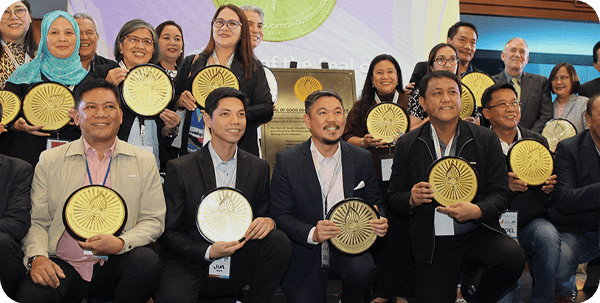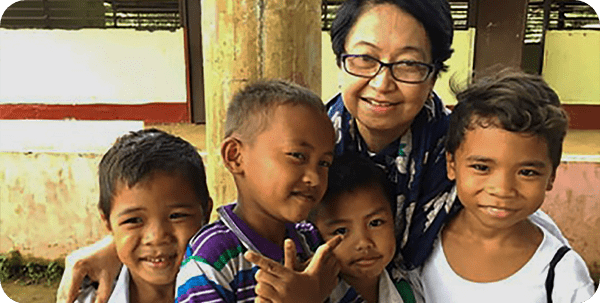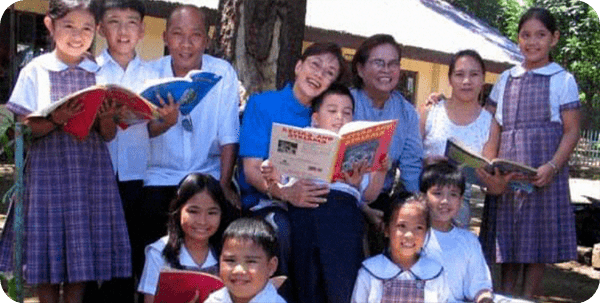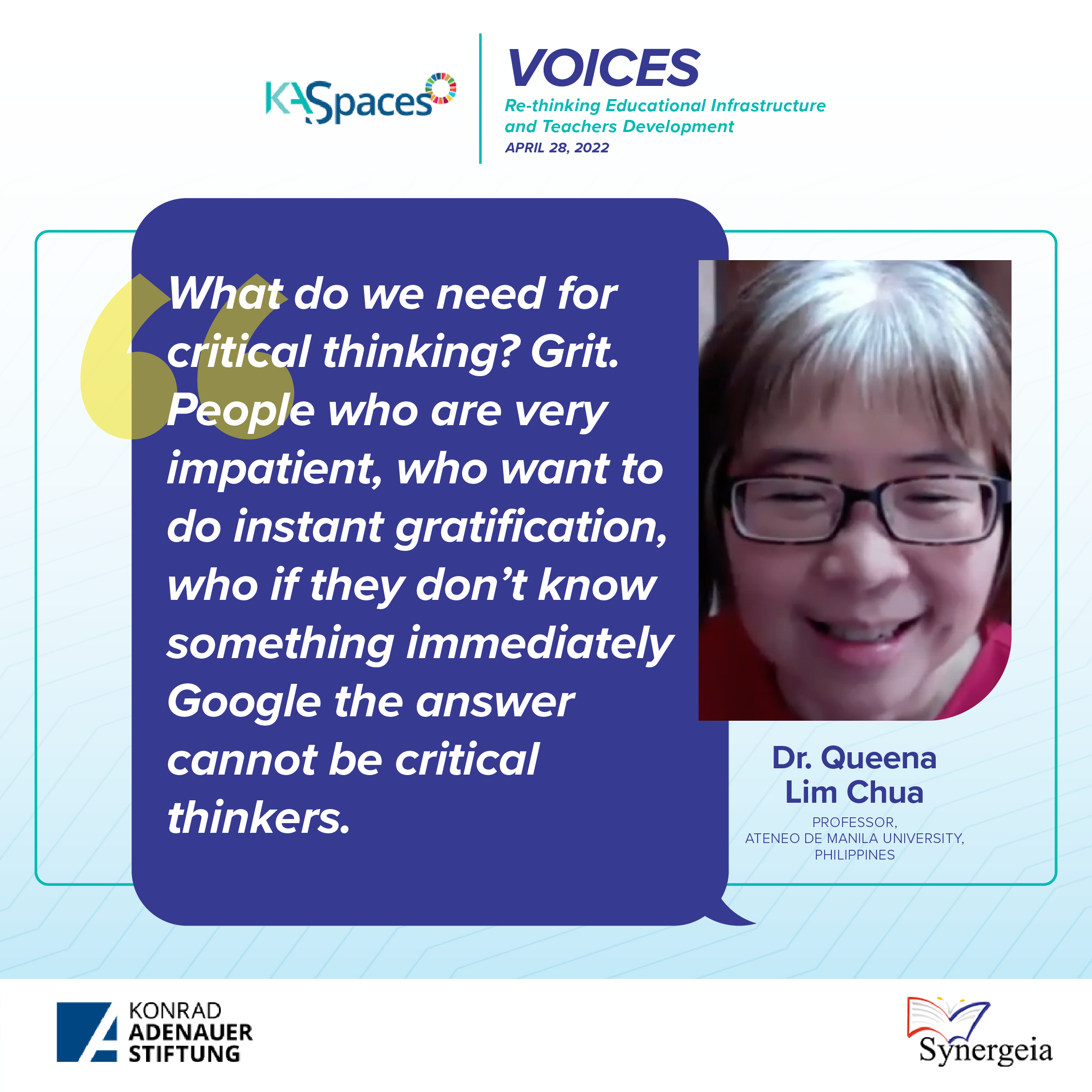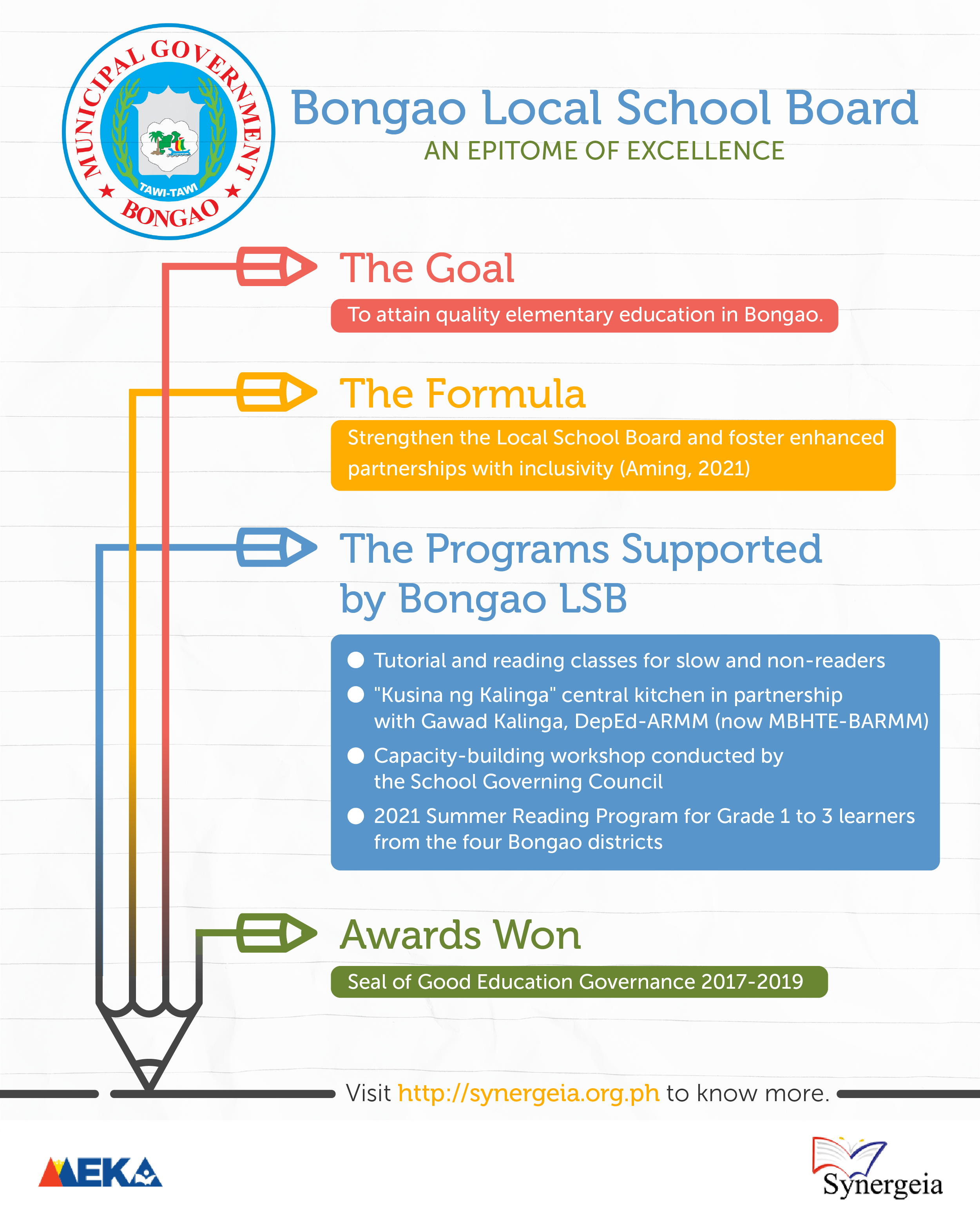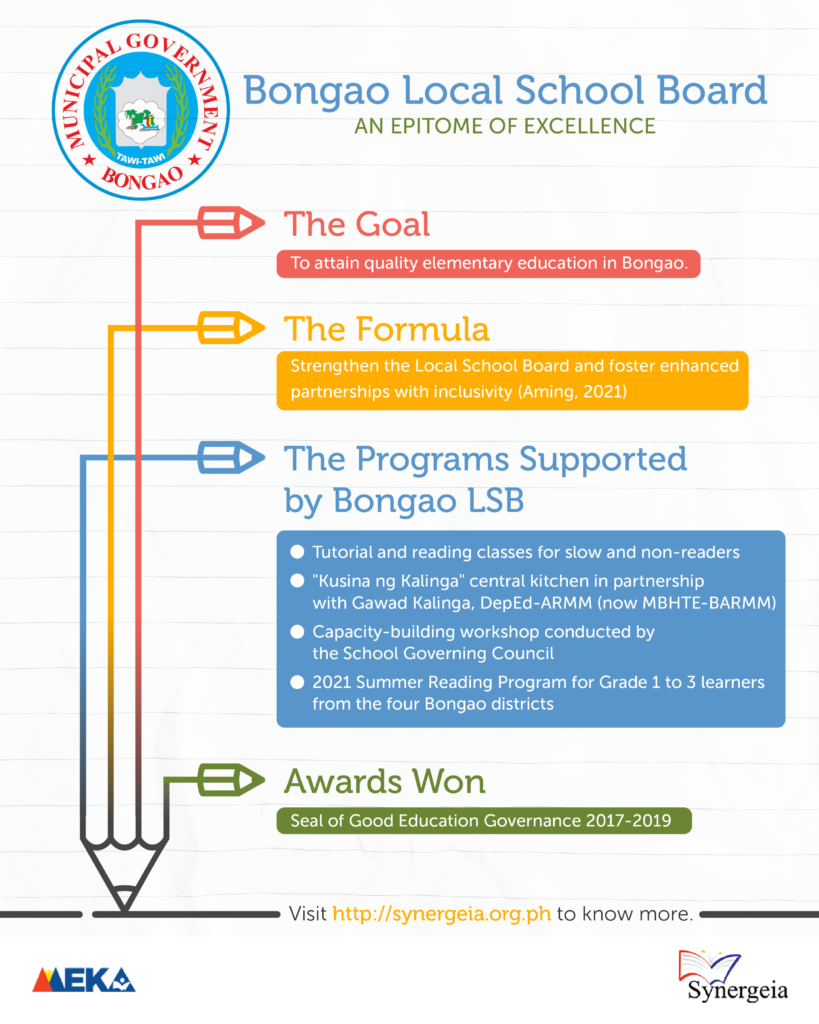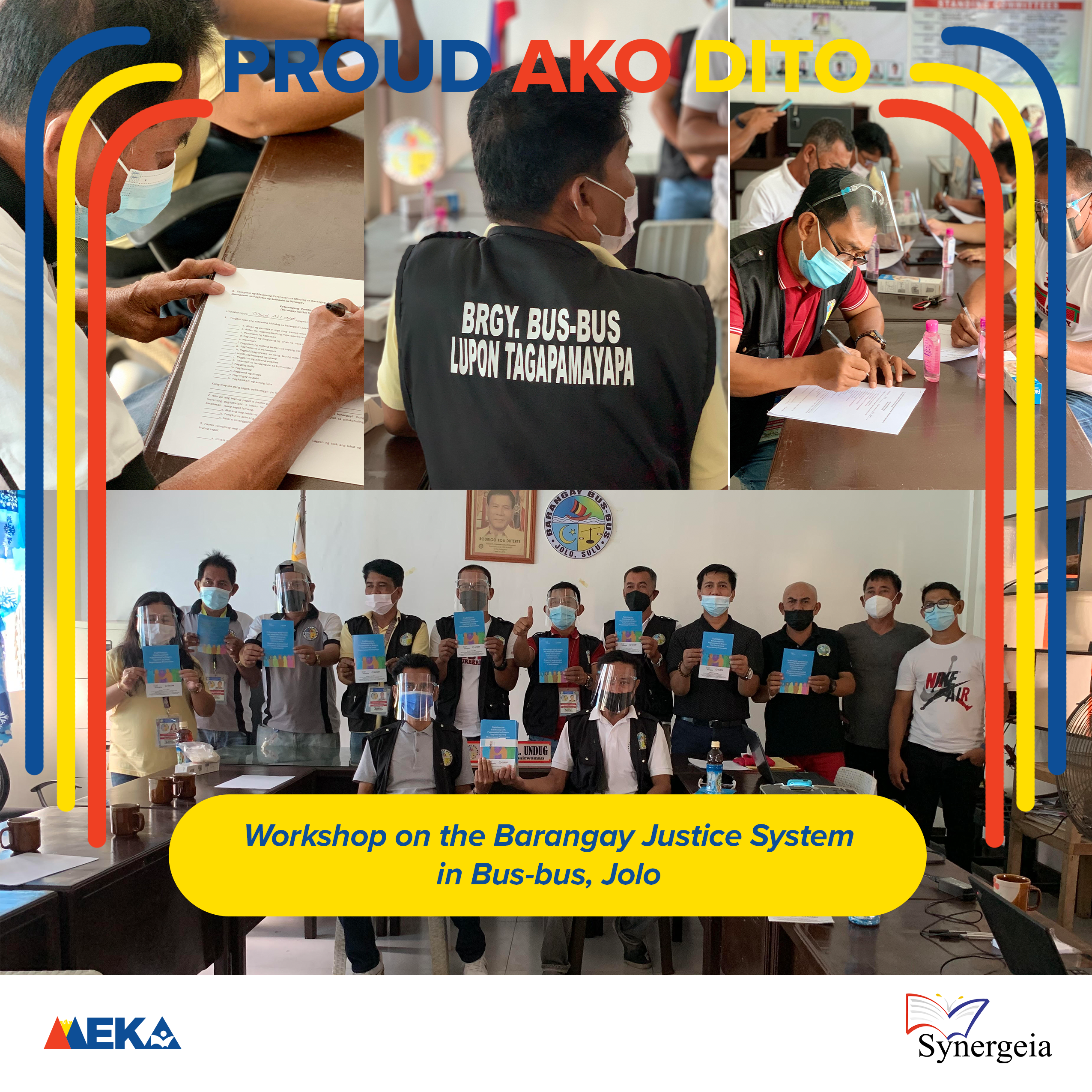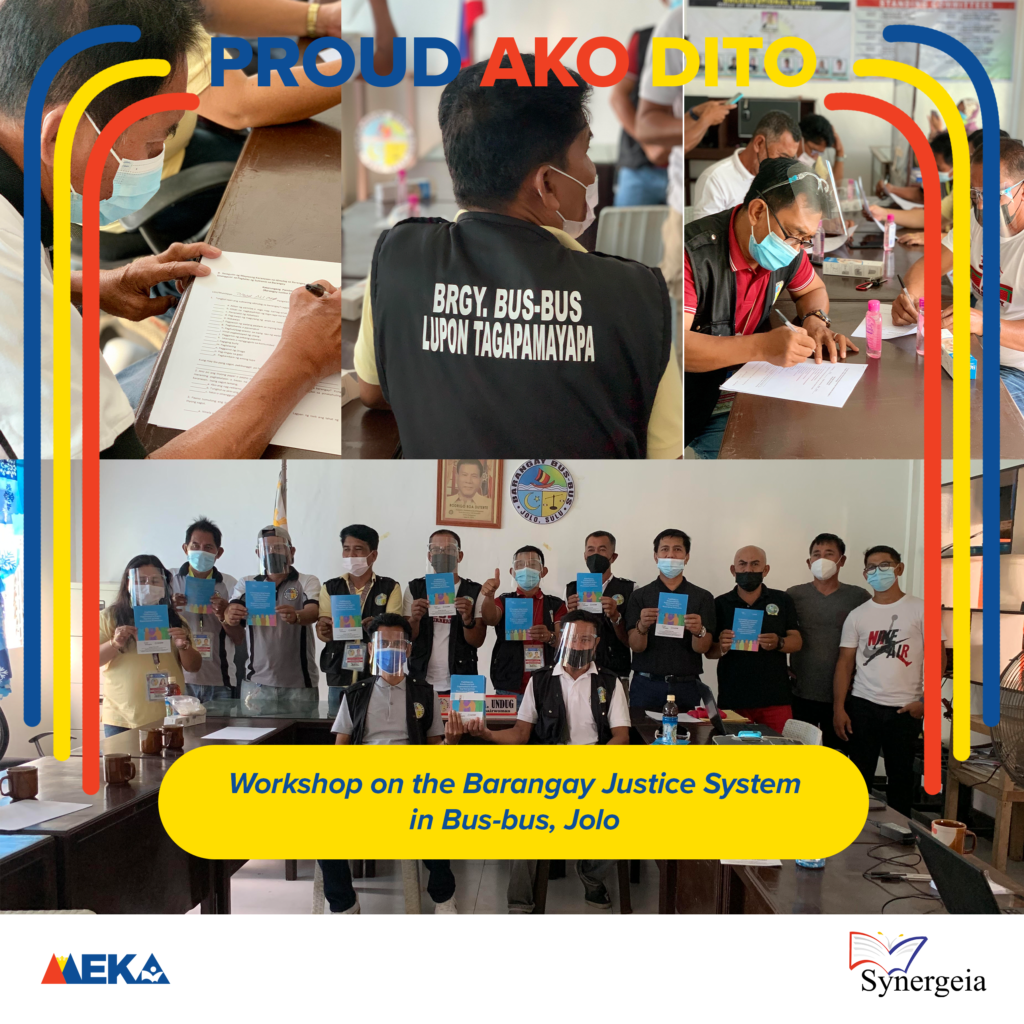KASpaces: Rethinking Educational Infrastructure and Teacher Development
April 28, 2022
The topic given to me is critical thinking but I want to add problem-solving because critical thinking is really used to harness problem solving, so let us start with a problem.
You land a gig for three weeks and are given two options for payment:
Option A: You are paid P100 for the first day, P200 for the second, P300 for the third, and on and on up to 21 days. Each day, you are paid P100 more than the previous day.
Option B: You are paid P1 for the first day, P2 for the second, P4 for the third, also up to 21 days. Each day, you are paid double the amount of the prior day.
Which do you choose?
Because I only have 20 minutes, I won’t ask you to answer this. But if we had longer time, I would have asked you to solve this one and give me the answer. I often give this to my students. When the pandemic started, I decided that there be some Mathematics behind it. But this was in April 2020. We did not know much about the pandemic yet and people were quite scared. Of course, I used money because that is what most people want to know about. Pre-pandemic, almost all my students said they preferred Letter A. But after I asked them to get their hands dirty, which means they literally had to write down each amount and add them for 21 days, then they get a shock because this is what is going to happen:
Week 1, it is obvious that A trumps B. Week 2, though, B is more than A. Week 3, which is horrendous: 12,600 vs 2-M. In Mathematics, you call the first one linear growth. The second one is called exponential growth. Virus spread is exponential. It’s not linear. You can start with one person and you can get two million in Week 3. So that was my explanation. People did not know what it meant. That is one example of critical thinking and reasoning in Mathematics.
I will go straight to what researchers say. How do we develop critical thinking? I wanted to get researchers who are Asian. I share the bias of Fr. Ben Nebres. He says we should learn from our Asian neighbors more than those of the West, so most of my literature would be Asian—how Asians do critical thinking and problem-solving. Most important of all is you have to master basic skills. You can’t really do critical thinking without them. That’s what shocks me sometimes. I’ve attended so many conferences on critical thinking. They have lots and lots of nice Power Point terms and, basically, the kids can’t do anything because they lack the basic skills. This is the elephant in the room that people do not want to talk about.
You cannot be innovative if you don’t have the basic skills, and this is what people don’t like. Many of my students hate it. They immediately want to get into the razzle dazzle of Math but they can’t even do Arithmetic sometimes. But after you master basic skills, we emphasize reasoning logic validity. They can identify possible solutions, evaluating, justifying, allowing them to be critical thinkers.
Meta cognition in psychology is also becoming a fad. It is a good fad—thinking about thinking, number sense. An example of number sense would be this: I would get very, very disappointed, and I tell that to my students when they do not even think about whether their answers make sense. For instance, just in basic probability, you ask them if you have a deck of cards, what is the possibility that when you pick one card randomly from 52 cards in the deck, it would be a heart? Usually, the answer would be one fourth. Sometimes, they would say one-fifth, one-sixth, two-thirds, that is fine. But what really irks me, and I do tell them is sometimes, is I would get an answer of – 6.4. I say, “What the heck is that?” Especially if we define probability to be anywhere between zero—zero means it will never happen—or 1 which means it is certain to happen. The answer must be a positive number, except that zero is neither positive nor negative, so zero to one. So, one-third, one-half, two-thirds, .6. It’s fine. But -6.2 probability doesn’t even make sense so there’s no critical thinking or meta cognition involved.
I have talked to certain professors in the Ateneo. Fr. Jett has a Physics degree. One of them, Dr. Joel Maquiling, tells me the horror stories he gets when he poses (very basic for him) mechanics questions to students. When the answer is something like a hundred kilometers, he tells me he would get an answer of two million. And he would just laugh. How could it be two million? Can’t you think about the validity of what you’re saying. So, that’s also critical thinking. That afflicts also, by the way, adults. But no time to talk about that.
Critical thinking guides students to identify scenarios, evaluate, select problem-solving strategies (this alone is what Fr Nebres and I teach), identify possible conclusions (and see if they are logical), describe, summarize, and indicate how they can be applied to more advanced problems and to real life. Focused thinking, planning, and strategizing are key aspects of organizational success, decision-making, and making life choices.
Going back to basic skills and applying them. This is a poster done by Ningning Roble and Dr. Nene Guevarra. Recently, my son and I did a Singapore math workshop with a hundred thousand teachers across the country. And there was no way out. Rather than giving a lecture, we spent three Saturday mornings, went overtime for all of them. The only way to do problem solving is to get your hands dirty and really solve the problem rather than theorize about it. Many of the people who theorize are actually so scared of getting their hands dirty. So, I was quite impressed by the tenacity of many of the teachers. I remember one teacher was up on a tree and you guys called her to answer and waited patiently for her to come down from the tree to do the solution. That inspired me so much. I told this to my students and I said none of you are on a tree, so please do not tell us you don’t have Wi-Fi. So, if there’s a will, there’s a way and it is problem solving. This young teacher wanted to learn. She did not have Wi-Fi, so she climbed a tree. That’s problem-solving.
Synergeia is at the forefront of doing Math. This is Basic Math plus problem-solving. This is the Model method; this is what we did. This forum is hosted by Singapore, so you know what Singapore Math is. We took this from your curriculum. I had a chat with some of your LOE before and Marshall Cavendish, the one who published the biggest textbook on Singapore Math. We are using it in the Philippines, in many schools. It is called the Model Approach and it’s learning by doing. I’ll do one more problem because this one has an obvious answer. Be honest with what your immediate gut answer is.
A big burger and giant fries together cost P100. The burger costs P90 more than the fries. What are the cost of the burger and the cost of the fries? If we are honest with ourselves, most of the time, the gut answer is, the burger costs P90 and the fries cost P10. That’s almost always the gut answer and of course it’s not.
This can be easily done with Algebra and, believe it or not, I’ve given this to several groups, ranging from Ateneo Grade 2 (they have a Magis Class, Grade 2 Grade 3). Before the pandemic, I used to give talks to them. We have the college, all the way to the executives. The ones that cannot answer this were the adults, the CEOs. The ones who did the best were the middle school students, not the primary but the middle school. Grades 6, 7 students did so much better. College students were very scared because they did not want to make mistakes. which is so sad. When they were younger, they were so open. The executives were not scared of making mistakes, but they made mistakes. The answer is not 9 and 10. The real answer is 95 and 5. Easy. When you get to think of the problem for a while, it’s easy.
Life is not about living without problems. I am at the forefront of mental health, which is sapping a lot of my energy. I prefer to stay in Mathematics. My students tell me life is difficult. I tell them, well that’s life. And many of them try to escape–social media and all that stuff. Gaming. It’s really escapist. A little bit of social media, a little bit of gaming is not bad to de-stress but getting addicted to it is not solving problems.
George Polya is the father of mathematics problem-solving. You can only learn it by imitation and practice. These are his four steps: understand, make a plan, do the plan, look back. These are all the problem-solving strategies that we use. When Fr. Ben and I teach the class, we go through the examples of these in Step 2. We give problems, sometimes problems that we don’t even know the answer to. You call it non-routine problem-solving.
I don’t know if I still have time, but just to tell students that Math can be hip, this is a clip from Die Hard…
(shows movie clip)
This is an example of a very old Mathematics problem. If you have a three-liter container and a five-liter container, how do you get four liters from three and five? That is a very simplistic problem. The students love it. They get their hands dirty. This is one way of doing it—you fill it up first, minus, add subtract, another one would be this, etc. What we do because we want to stretch their thoughts, after getting their answer, which practically everybody gets, we would ask them to stretch it and ask, “What is the general pattern that you see?” Suppose you have 10 liters and 8 liters: how do you get nine? And we would ask the computer science people to do a program. We would ask the business people to do something. We would ask the Math people to use calculus, etc. etc. One small problem would lead us to lots and lots of bigger problems which, despite themselves, the students find interesting.
What do we need for critical thinking? Grit. People who are very impatient, who want instant gratification, who, if they don’t know something, immediately Google the answer cannot be critical thinkers. The definition, mali na. It’s wrong. It can’t be done. Angela Duckworth defines grit as very long-term goals. Not just for the week, but for years. Life is a marathon and not a sprint and in my Positive Psych class, we talk about Carol Dweck’s fixed and growth mindsets wherein I really embrace challenges instead of avoiding them, persevere instead of giving up, and what I would really like to enjoin if there is a way, Konrad Adenauer, Synergeia, I myself and several other science teachers—Ateneo’s School of Science and Engineering (SOSE), finished a resilience study because, in the pandemic, we are not too happy with the resilience of several students yet we were very happy with the grit of some. So we wanted to see.
For science, you really need grit because there is no way you can do fast science. We were not very happy when several students run from error, when they ignore negative feedback. You give them feedback and they get mad, they cry, they avoid new experiences. The students tell it this way: they don’t really trust each other. Rather than friends, they have frenemies so they are really threatened if somebody else is successful.
We did a study on what makes our science students gritty. The Asian value would be: faith is there to my surprise. Many of the gritty students say they really find comfort and strength in faith. Which is not a Western finding. I was very shocked by that. Faith and, of course, being Filipinos, family is such a support. That one didn’t come out in Western literature, and friends who hold them accountable. This is all part and parcel of critical thinking, especially the second part. And cheating is rampant, not just in our country but world-wide. I was talking to a Western educator. Googling is not learning They Google the meaning of their lives. Which is so sad. A series of problems either defeat you or develop you depending on how you respond to it. And that’s it. Thank you
